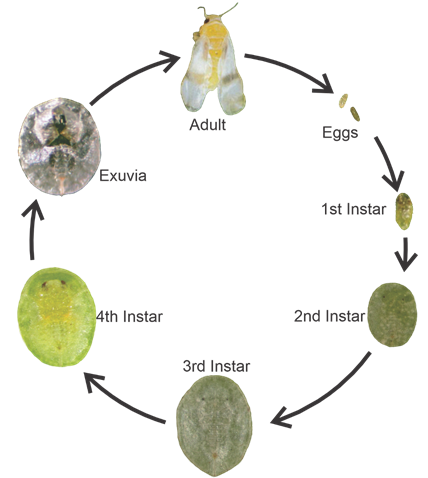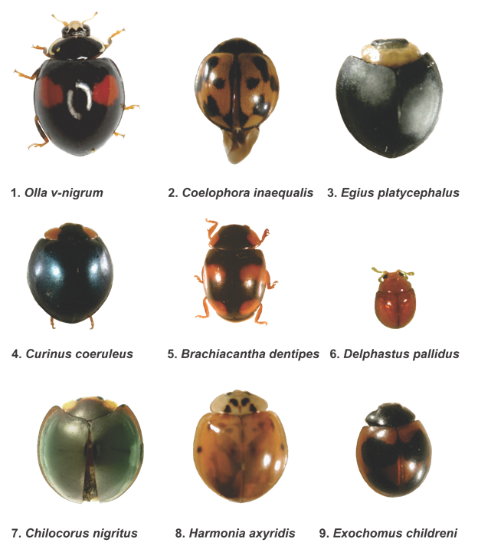Ficus Whitefly, Singhiella simplex (Hemiptera: Aleyrodidae)

Figure 1. Healthy (A) and infested (B) Ficus hedges in close proximity, Homestead, Florida. (photo credit: M. Z Ahmed from USDA).
|
Subtropical Insects and Horticulture Research, Agricultural Research Service, United States Department of Agriculture, 2001 South Rock Road, Fort Pierce, Florida, USA Department of Entomology & Nematology, Tropical Research and Education Center, University of Florida-IFAS, 18905 SW 280th Street, Homestead, FL 333031 Department of Entomology & Nematology, Mid-Florida Research and Education Center, University of Florida-IFAS, 2725, S. Binion Rd., Apopka, FL 32703 |
|---|
Introduction
Ficus whitefly Singhiella simplex (Singh) (Hemiptera: Aleyrodidae) was first described on Ficus benghalensis L. from Pusa, India in 1931, and it was subsequently reported in surrounding countries. Southeast Asia appears to be its home range, and from there, it has invaded much of the world except Australia. Singhiella simplex was first detected in the USA in 2007. It feeds on both the dorsal and ventral of leaves. It damages host plants by sucking sap, resulting in extensive leaf drop, leaf yellowing, honeydew secretion, sooty mold, branch dieback, stunting, wilting, and eventually death.
Biology
Adult S. simplex have dark red eyes with a pale yellow body, are 1.3–1.6 mm in body length, and are mostly found on the underside of leaves. Wings are white and waxy. Each wing has two grayish-brown markings, one like a band in the middle slightly slanting towards the inner wing margin, and the other one like a stripe towards the top edge of the wing, parallel to the inner wing margin. Eggs are almost transparent, elongate in shape, and are found along the midvein on the underside of leaves. First instar nymphs (crawlers) do not feed, rather they move around on the same leaf they hatched and settle down upon finding a suitable feeding site. They insert needle-like mouthparts into leaf tissue, remain in this location, and feed throughout the 2nd and 3rd instars. Early nymphal instars are flat, oval, translucent, have red eyes, and appear more like the early nymphal instars of soft scale insects than typical whitefly nymphs on Ficus plants. They can be found on both the lower and upper surfaces of leaves, unlike many whitefly species that only live on the underside of their host leaf. The 2nd and 3rd instars are oval in shape and tan to light green in color, often semitransparent, camouflaging with the surroundings. However, they turn more opaque and pale yellow as they grow. The 4th instar (also known as puparium) is about 1.1–1.3 mm long, tan to light green, continues to feed until the adult body begins to develop inside the puparium. The red eyes of the adults become visible at this stage. The adult then breaks the T-shaped slit of the puparial case and emerges.

Figure 2. Life cycle of Singhiella simplex (Ahmed et al. 2022).
The total duration of the life cycle from egg to adult depends on temperature, and is fastest in the warm summer months, averaging around 30 days from egg to adult.
Chemical Control of the Ficus Whitefly
Click here: Chemical control of the Ficus whitefly
Natural Enemies in Florida
Figure 3. Images of predatory beetles of Singhiella simplex reported in Florida (Ahmed et al. 2022). (photo credits: C. Mannion, H. Glen, Y. V. Hernandez from University of Florida, M. Z. Ahmed from USDA).

Figure 4. Images of parasitoids of Singhiella simplex reported in Florida (Ahmed et al. 2022).. (photo credits: M. Z. Ahmed from USDA).

Figure 5. Images of other predators of Singhiella simplex reported in Florida. (photo credits: M. A. Canon from University of Florida, M. E. Talbot from Flickrand).

Figure 6. Images of entomopathogenic fungi known to infect Singhiella simplex in Florida. Isaria fumosorosea associated with early and late instars of other whitefly species (Aleurodicus rugioperculatus), Lecanicillium species associated with 4th instar of Singhiella simplex and Purpureocillium lilacinum associated with 4th instar of other whitefly species (Bemisia tabaci). [photo credits: P. B. Avery from University of Florida, V. Kumar from University of Florida, M. A. Canon from University of Florida) and Sun et al. 2021 (Egyptian Journal of Biological Pest Control)]
Other Whitefly Species Associated with Ficus Hedges in Florida

Figure 7. Life stages of Paraleyrodes bondari, the second most prevalent whitefly species infesting Ficus hedges in Florida. (A) adult females and eggs, (B) eggs and white waxy power, (C) settled 1st instar in the nest, (D) 2nd instar, (E) 3rd instar, (F) 4th instar puparium in nest, (G) naked-eye view of Paraleyrodes bondari infestation on the underside of the leaf. (photo credits: M. Z. Ahmed from USDA, and Y. V. Hernandez from the University of Florida).

Figure 8. Puparia and adults of whitefly species on Ficus species. (A–B) Aleurodicus rugioperculatus, (C–D) Paraleyrodes bondari, (E–F) P. minei, (G–H) P. pseudonaranjae, (I) puparium of Tetraleurodes fici, (J) adult of T. mori as an alternative because the image of T. fici adult was unavailable. (photo credits: I. C. Stocks from APHIS-USDA, L. Buss from the University of Florida, and M. Z. Ahmed from USDA).

Figure 9. Puparia of whitefly species on Ficus species. (A) Singhiella simplex, (B) Tetraleurodes fici, (C) Aleurodicus rugioperculatus, (D) Paraleyrodes bondari, P. minei, and P. pseudonaranjae. (photo credits: I. C. Stocks from APHIS-USDA, L. Buss from the University of Florida, and M. Z. Ahmed from USDA).
Comparison of Sizes and Shapes of Common Whitefly Species in Florida
Figure 10. Comparison of sizes and shapes of common whitefly species in Florida, adults (A) and puparia (B). 1) sweetpotato whitefly/silverleaf whitefly, Bemisia tabaci, 2) solanum whitefly, Aleurotrachelus trachoides, 3) Bondar's nesting whitefly, Paraleyrodes bondari, 4) rugose spiraling whitefly, Aleurodicus rugioperculatus, 5) giant whitefly, Aleurodicus dugesii. (Photo credits: M. Z. Ahmed from USDA).
Resources
Pest Alert from 2007
- The Fig Whitefly Singhiella simplex (Singh) (Hemiptera: Aleyrodidae): A New Exotic Whitefly Found on Ficus Species in South Florida
The Most Recent Publications
- Pest Status, Survey of Natural Enemies, and a Management Plan for the Whitefly Singhiella simplex (Hemiptera: Aleyrodidae) in the United States
- Whitefly (Bemisia tabaci) Management Program for
Ornamental Plants - Managing Whiteflies on Landscape Ornamentals
- Biological Control of Whiteflies with Entomopathogenic Fungi
- Don’t Bet Your Hedges: IPM Guide Outlines Ficus Whitefly Management
Other Related Publications
- Whitefly (Bemisia tabaci) Management Program for
Ornamental Plants - Managing Whiteflies on Landscape Ornamentals
- Biological Control of Whiteflies with Entomopathogenic Fungi


